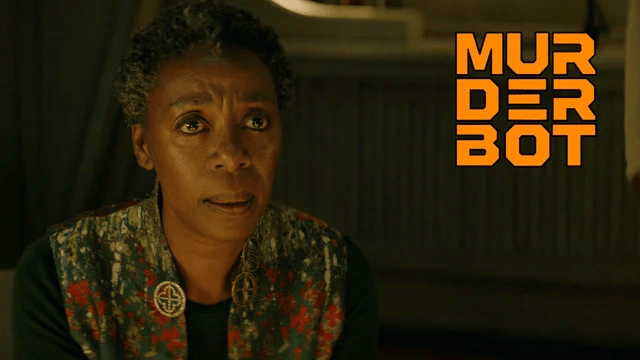- Escapist Routes
- Posts
- Escapist Routes #19
Escapist Routes #19
a win for the homicidal asexual community
I do NOT like changing my routine. And that goes for newsletter posts as well as everything else in my life.
But last week, I got sick. It went from “a conversation with a coworker about how he was losing his voice” on Monday to “feeling a little seedy” on Tuesday afternoon to “I am very ill, losing my voice and coughing until I throw up” from Wednesday to, uh. Well, I’m still a bit croaky. Zero stars, do not recommend.
To make matters worse, my flatmate was scheduled for surgery, and there was no way I was going to jeopardise that. So I took to my bed and spent a lot of time resting and watching SVU.
But! I’m recovering, my flatmate’s operation was successful and now she’s recovering, and I need to thank everyone who didn’t spoil me for the finales of Poker Face and Murderbot. In return, I will spoil you all for the big “twist” in Smoke, but at the bottom of this post so you can skip it if you want the full Smoke experience.
Murderbot, season 1, episode 10
While I was sick, I spent a morning in bed rereading All Systems Red. This served to increase my irritation at the adaptation’s handling of the PresAux team and their interpersonal relationships, and particularly the choice to combine Pin-Lee and Overse — but also increased my admiration of the way the adaptation has expanded on a lot of things which the novella conveyed in a few paragraphs.
This is especially true of the final episode, which takes the events of the book but ramps up the tension — here, Murderbot’s memory is actually wiped, and has to be retrieved by Gurathin, who figures out that Murderbot hid its records in a Sanctuary Moon torrent. But not before Murderbot almost commits a bit of a massacre (again).
It’s a lovely culmination of the parallels built into their stories, and does not take away one bit from the fact that Murderbot’s primary relationship, its canonical favourite human, is Dr Mensah.

(Same.)
That it ends with Mensah receiving Murderbot’s farewell message, smiling and crying as it takes its first steps towards “adulthood” after its “childhood” of leaning to be a person via media, is perfect. The final sequence sees Murderbot moving through a transit hub, a setting type we’re going to spend a LOT of time in, and it was here that I sort of exhaled (and coughed a bit) and thought, yes, this is the Murderbot I wanted.
Poker Face, season 2, episode 12
Okay, I was completely bamboozled. Poker Face pulled the wool over my eyes, and I am delighted. Alex was the assassin all along, and EVEN BETTER, she is a hot, evil, leather catsuit-wearing asexual nemesis for Charlie: a person whose psychopathy is so profound, she can lie to Charlie’s face for WEEKS and get away with it.
Also, she once wrestled a polar bear and uses its remains as decor.
They both survived the Thelma and Louise ending (RIP Charlie’s car), and the premise has reset itself: Charlie is once again on the run, but this time, from the FBI. And I’m like, okay, yes, she did lead an assassin to the location of a federal witness, but is that really a “life in federal prison” sort of crime? I feel like a decent lawyer could sort Charlie out here, but unfortunately Charlie doesn’t really have “decent lawyer” money.
The season ends with Charlie and her new stray dog friend hitching a ride with a truck driver, which I assume is how she’s going to come back into Good Buddy’s orbit now her car (and CB radio) are gone. I’m sorry I distrusted you, Good Buddy! I can’t wait to meet you in person next season!
I gotta say, between Mel in The Pitt, Murderbot in … you know … and now Alex here, this is a big year for asexual representation in media. The homicidal ace community is especially winning, and I appreciate that.
Foundation, season 3, episodes 1 and 2
When I was 13, I read nearly everything Isaac Asimov wrote. Every single novel and short story I could get my hands on, and that was a lot, because my dad was a fan and we spent a lot of time in used bookstores. But I drew the line at Foundation, because I looked at the premise and said, “That’s not how maths OR history work, Isaac.”
At the end of that year, I discovered Anne McCaffrey, and never went back. My time with the stale, male and pale classics of science fiction was done.
Despite all this, or maybe because of it, I really enjoy the AppleTV+ adaptation of Foundation. For one thing, it agrees with me that psychohistory is basically magic; for another, like me, it looks at Asimov’s work and goes, “So … maybe there could be some women here?”
(I’ve only read one work in the Foundation series — I finally read the title novel in 2022 — but I understand that the whole universe contains exactly two female characters.)
Don’t get me wrong, Foundation is a load of wank. It’s a magnificent combination of portentous voiceovers, hushed palace intrigue which amounts to very little, and luscious scenery, while Lee Pace wears a series of improbable and increasingly revealing costumes. (The costumes are also outstanding.) Eventually everything more or less coalesces into a plot, which is resolved before we reset for the next season.

You’re welcome.
I don’t want all television to be like this. I don’t think I could tolerate more than ten episodes every two years. But I love it. (I also love Dune: Prophecy, which is in many ways HBO’s Temu knock-off of Foundation. I’m frankly a sucker for elaborate costumes and palace intrigue in space.)
ER, season 13
Let me tell you, guys, season 13 of ER was a real slog. Usually we knock a long season over in a few weeks, but here we kept taking breaks to watch other shows, because, well. It was bad.
I know conventional wisdom has it that ER fell off around season 9, when Dr Romano — who had already lost an arm in a freak helicopter accident — died in a second freak helicopter accident. And I definitely think that’s when the series finally completed its pivot from “medical drama” to “soap opera set in a hospital”, but there were still a lot of characters I deeply cared about, and the ratio of “good writing” to “nonsense” was still working for me.
That started to change in season 12, when John Leguizamo is completely wasted as an inconsistently-written new doctor whose storyline piles melodrama upon melodrama. But again, there were characters I cared about.
Season 13 still has characters I cared about — but note the past tense, because aside from Abby Lockhart, My Queen, my interest in following them declined substantially as they were diverted away from medical storylines and into far less interesting personal relationships, love triangles and general nonsense. (Truthfully, my affection for Abby mostly survives because Maura Tierney plays her with such a consistent aura of “can you believe I have to put up with this bullshit?”)
Here’s a handful of the key missteps:
Pratt and Luka both have subplots about how African American men are under-served by the healthcare system, in part because they have good reason not to trust it. Do these storylines converge? No, but we do get multiple episodes of Luka being stalked and eventually tortured by Forest Whittaker.
We absolutely did not need a storyline about Sam being abducted and raped by her ex, then killing him to escape only to realise her son saw and heard the whole thing.
Then, in what I have to say is probably the most 2006 (derogatory) development in the entire series, Sam then sends her son, who is acting out and kind of burned a building down, to a school for troubled teens. This is one of the relatively few times when it feels like ER was not, accidentally or deliberately, on the right side of history.
Every single relationship Neela has is either ignored (her friendship with Abby) or becomes romantic, including her bond with her mentor and her rivalry with another resident. In every case, Neela is completely passive, which actually makes sense given that she’s still processing the death of her husband (who died in Iraq, because it’s 2006), but I have to seriously question the judgement of whoever decided this freshly widowed character should be returned to the dating pool as soon as possible.
Everything to do with John Stamos’s character.
I’m told that season 14 sees a general improvement in quality, and I hope that means ER is going to stop trying to out Grey’s Grey’s Anatomy. Because obviously I’m going to keep watching.
Smoke, season 1, episodes 1-5
Smoke is a drama about an arson investigator who teams up with a cop to chase down two serial arsonists, and reviews promised a DRAMATIC TWIST.
“I bet the arson investigator is also one of the arsonists,” I said.
Then I read that the series is based on a true crime podcast about serial arsonist John Orr. “I think I listened to the My Favorite Murder episode about that,” I said, “wasn’t he the arson investigator who was lighting fires?”
Anyway, you are not gonna believe this, but the twist is that the arson investigator is an arsonist.
No, I know, I was shocked too.
We learn the truth at the end of the second episode, which concludes a couple of frustrating hours of wondering if we are meant to enjoy this character or find him deeply off-putting. And I actually have to applaud the writing for how well it threads the needle — I hated him, but he was so good at conveying the “heroic, no nonsense first responder with a complicated marriage and secret creative side” that I really did feel like maybe it was just me who had a problem with him.
I started to feel like it was intentional in season 2, when he gets multiple pieces of feedback on his unpublished novel (it’s about a heroic and sexy arson investigator, of course) that maybe he should try including a single female character. And then, after a fight with his wife and stepson, he goes out and burns down a convenience store. Totally called it, well done, me. And well done this show for really capturing a specific type of misogynist.
The cop who is going to bring him down is a much more interesting character. Like, yes, she’s an asshole cop who breaks the rules and has some sort of problem with wearing a seatbelt, but she’s also a mixed race woman, and that automatically increases my level of interest in a character. Played by the always-excellent Jurnee Smollett, she has been seconded to the arson squad after she tried to break up with her married boyfriend, who is also her boss.
So she, too, is an asshole, but again: I have a double standard. And also she’s not burning anything down. Yet.
Also, there is no classy or polite way to say this, but she has magnificent breasts. Which the show wants us to know, because she spends a lot of time breasting boobily in the first two episodes. I know I should be mad, but maybe feminism means a woman can have a career and amazing gazonkadonks. I just need to know what her bra is, because there is so much cleavage and so little jiggle. Please. I will pay a lot of money for that.